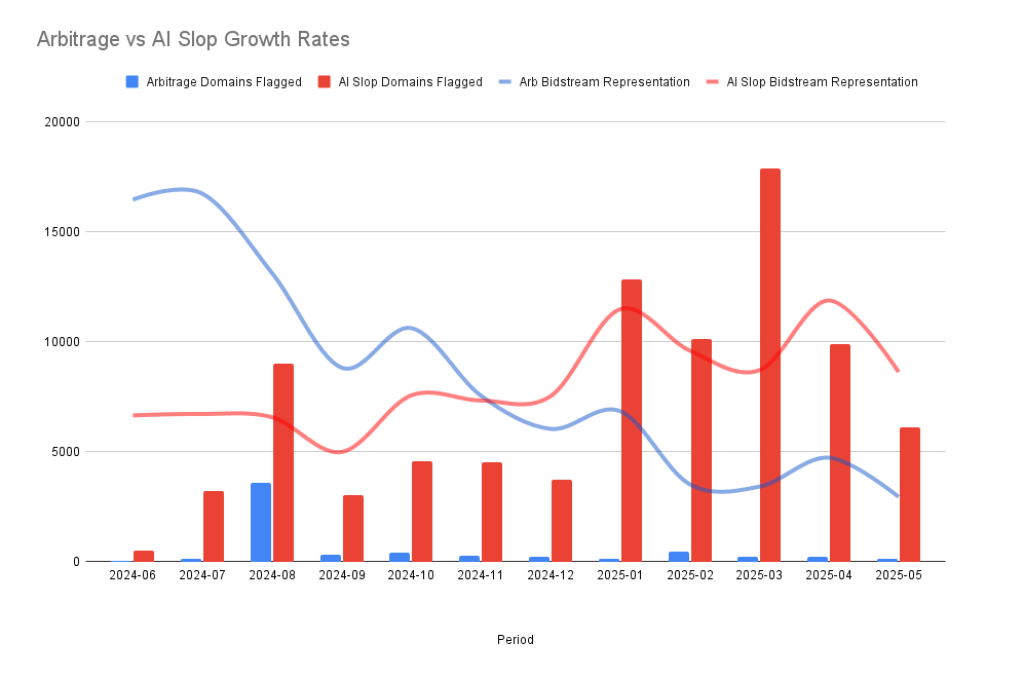Join us Dec. 1-3 in New Orleans for the Digiday Programmatic Marketing Summit

This article is a WTF explainer, in which we break down media and marketing’s most confusing terms. More from the series →
In today’s tech lexicon, slapping “AI” in front of a problem, or a product, is the fastest way to make something old sound new, whether it’s clickbait, content farms, or a decade-old dashboard with a fresh coat of hype. The same can be said for AI slop — a term that seems to have gradually gained traction among media and marketing professionals over the last six months/year.
Nevertheless, while “slop” may have been an informal and unofficial way to refer to shoddy sites created purely for the purpose of arbitrage — a problem that’s plagued publishers and advertisers for decades — there’s no denying that generative AI is accelerating the scale of this to unprecedented levels. The upshot: media metrics are going to get skewed, big time.
And with the looming economic uncertainty brought on by the U.S. tariffs, that’s going to end badly for performance budgets if buyers aren’t proactive, some experts say. For publishers, it’s déjà vu — and their cut of the programmatic pie is only shrinking.
Let’s break it down.
What is AI slop?
It’s an umbrella term to describe what’s always existed in digital media in various guises (think click farms, MFA sites) but the difference now is the speed at which these sites are able to proliferate and monetize. And that’s due to the surge in generative AI use since OpenAI’s ChatGPT went mainstream. That means that you no longer even need to understand anything about how to code a website. Your own grandma could set up a slop site populated with synthesized, plagiarized content scraped from across the web, with images, fake authors or bylines, within days, and have it monetized with ads within a month or two. “AI slop is the next iteration of MFA,” said Iesha White, director of intelligence at Check My Ads Institute, an independent digital advertising watchdog. “It is easier than ever to proliferate millions and millions and trillions of pages in any given day,” she added.
What kind of scale are we talking?
Here’s a look at how the rise of AI slop sites compares with the trajectory of MFA sites and also the rate at which AI slop is appearing in programmatic ad bidstreams. The data has been compiled by Deepsee.io, an intelligence platform that analyzes millions of signals daily to detect and mitigate ad fraud in programmatic advertising.
There has been a 717% increase in AI slop sites detected in the last year, according to Deepsee.io data shared with Digiday. The platform’s block list of MFA and AI Slop was 17,124 domains long in June 2024, and as of May 2025, it was 108,270 domains long; of those, 96,791 domains were classified as AI slop. Rocky Moss, co-founder and CEO of Deepsee.io, stressed that these figures are likely conservative.

“Probably almost every site that’s entering the bidstream every week is not worth your time, and looks like some flavor of AI slop,” said Moss. He added that the speed at which these sites are proliferating is what’s clogging up programmatic pipes.
Are they easy to spot?
There are telltale signs for a lot of them. Fake bylines, or even no bylines, fabricated writers that have no digital footprint, clone-like design similarity — like basic templates that make for a fairly generic design experience. And their content is plagiarized, mercifully scraped from other sites that have paid writers to create it. So a lot of the time, it’s hallucinatory and nonsensical.
“These AI slop sites have also been gamified, they’re refreshing their ad slots constantly, there’s an overabundance of ad slots. There are really sticky video players in the corner that have great viewability. So the metrics look ok, but it’s not an ideal user experience,” said White.
Seemingly high metrics have historically caused buyers to look the other way.
Right. And though there have been a lot of efforts to move away from that over the last few years, the economics of the digital ad industry don’t lend themselves to an easy fix, White stressed. “We, as the advertising community in the industry at large, need to be looking away from the historical way we look at programmatic, which is based on volume. That’s kind of a suckers mode at this point,” she said. Buyers need to consciously and aggressively target by quality of site, and not leave it all up to automation, she added, stressing that just using blocklists is too blunt a measure. “We’re disenfranchising publishers that do employ actual humans that do provide quality content, and when advertising budgets are finite — it is pie, and if so much of the pie has to go to AI-generated slop or MFA, that means that’s less piece of the pie that legitimate publishers don’t get,” she said.
And with the current economic uncertainty, advertisers also can’t afford metrics gamification
Yes, this additional pressure means that marketing budgets are being scrutinized. It’s really hard to justify, not only to a CMO, but to a CFO of a brand, why a campaign has driven a high CTR but not correlated to any net incremental sales. “If you don’t have a good answer for that, programmatic, generally is one of the first channels to be cut in my experience,” added White.
Programmatic advertising hasn’t typically gone hand in hand with quality curation. “Our emphasis for so long as programmatic buyers, and how program has been sold through, is making the long tail accessible, and I think people are clinging to that,” said White.
How can we prevent it?
Cue nervous laughter.
There is no preventing it. AI slop is here to stay. There is no real policing that can be done with it. It’s already warping media metrics, it’s already inflating engagement metrics and distorting programmatic ad buys, according to experts interviewed for this article. The real question is, “how do buyers ensure they’re not squandering their dollars like this?”
As for reputable publishers, they’re tuned in to it, but as with many things, it’s down to the buy side and SSPs and DSPs to block. “It feels like publishers are very aware and very, like, almost panicked,” said Lily Ray, vp of SEO strategy and research for performance marketing agency Amsive.
“A lot of this [policing of AI arbitrage] really falls on governments, not publishers,” she said. However, she pointed to the government’s “one big beautiful bill act” proposed last week, which pushes to ban state regulation of AI in the U.S. for 10 years. “It doesn’t look too promising right now in the U.S. for the government to step in in any meaningful way,” she said.
There are some levers, though, that can help?
Right, like having target lists of approved publishers — a strategy publishers have long touted until they’re blue in the face. “You can still do that and achieve huge scale, and also stay completely insulated from this AI slop,” said Moss.
Another tip for platforms: If a site or app appears in the bid stream that you’ve never seen before, give it a month or two before you start bidding. “Don’t just start bidding on inventory you’ve never seen before — that is one of the truly only ways to avoid this class of abuse,” he added.
White is hopeful this AI-slop runaway train will actually lead to (yet another) push to quality over quantity buys. “I think we’re going to see even more demand for real, authentic content. So I think things like sponsored content will proliferate, really big, high-impact takeovers, and a big emphasis on video will proliferate. Video pre-roll, in my opinion, is probably harder to game with AI-generated,” added White.
More in Media

Media Briefing: Publishers turn to paid audience acquisition tactics to tackle traffic losses
Publishers facing declining organic traffic are buying audiences through paid ads and traffic arbitrage, and using AI tools to do it.

When bots look like buyers: agentic traffic causing new publisher headaches
The real issue is measurement: without a clear way to separate agentic visitors from humans, some buyers are getting jittery — and a few are already pulling ad spend.

Job cuts hit 22-year October high as retail layoffs from Amazon to Target mount ahead of holidays
Employers slashed 153,074 jobs last month, up 175% from a year earlier, according to Challenger, Gray & Christmas.








